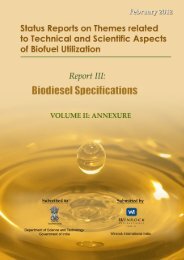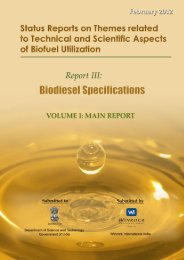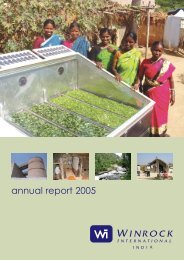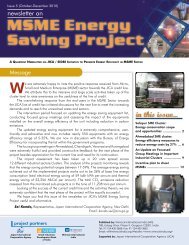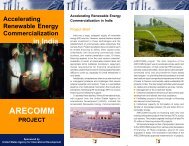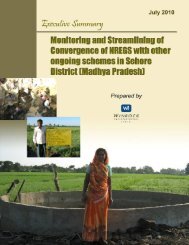IssuE 8 â ApRIl â JuNE 2011 - Winrock International India
IssuE 8 â ApRIl â JuNE 2011 - Winrock International India
IssuE 8 â ApRIl â JuNE 2011 - Winrock International India
Create successful ePaper yourself
Turn your PDF publications into a flip-book with our unique Google optimized e-Paper software.
Energy from Bamboo<br />
yield to obtain is 2,000 mm per year,<br />
however it can grow in the regions<br />
having average rain fall from 1000<br />
mm onwards. Best growth of Beema<br />
bamboo is achieved under high<br />
humid condition with well spread<br />
rain or irrigation along with regular<br />
application of adequate fertilizer as<br />
per the soil condition. This bamboo<br />
reaches a growth speed of 1 to 1 ½<br />
feet a day after it attains the age of 2<br />
years. The fertilizer requirement for<br />
Beema bamboo is 160: 40: 200 NPK per<br />
acre, which should be altered based on<br />
the soil tested at 6 inches depth and 2<br />
feet depth.<br />
Harvesting of Bamboo<br />
Bamboo can be harvested throughout<br />
the year except during monsoon. At<br />
the time of harvest the bamboo pole<br />
will have 40% moisture and it should<br />
be dried to 10 to 15% before using as<br />
fire wood. The drying of bamboo is<br />
faster and quicker after it is being split<br />
in to two or made into chips as per the<br />
requirement of the boiler.<br />
The expected yield on a dry basis (10<br />
to 15% moisture content) under well<br />
managed condition is as given below:<br />
Period<br />
Quantity<br />
End of 2 nd year 30 to 40 tons<br />
End of 3 rd year 40 to 50 tons<br />
End of 4 th year 50 to 60 tons<br />
End of 5 th year 60 tons and above<br />
Bamboo has wide range of climate<br />
adaptability. It can tolerate<br />
temperature of 2°C to 45°C. and can be<br />
cultivated in any type of soil. Unlike<br />
other trees it does not deplete ground<br />
water (bamboo has got shallow -<br />
adventurous root system). It has got<br />
higher water use efficiency of 3.8 to<br />
8.1 g/lit. It rejuvenates faster than any<br />
other tree species. It usually sheds its<br />
leaves during dry months and when<br />
there is supply of water or rain it starts<br />
to grow, it will not die unlike most of<br />
the tree species.<br />
Bamboo sequesters carbon faster<br />
and higher than many other biomass<br />
trees. The root and rhizome portion<br />
of bamboo also plays a role in<br />
sequestering carbon. It acts as a carbon<br />
sink as it absorbs excess CO 2<br />
in the<br />
air with three to four times more<br />
efficiency than any other tree. Which<br />
means, the more bamboos we plant,<br />
the more CO 2<br />
is absorbed and thus<br />
we can stop neutralizing the global<br />
warming effect.<br />
Though there are many entrepreneurs<br />
interested in investing in biomass<br />
based power generation, shortage<br />
of biomass remains a major obstacle<br />
in establishing renewable energy<br />
projects. Establishment of bamboo<br />
based energy plantation would<br />
permanently solve the raw material<br />
requirement (biomass) for renewable<br />
energy projects.<br />
Courtesy: Dr N Barathi<br />
Director, Growmore Biotech Ltd.<br />
Email: growmore@vsnl.com<br />
Request for Articles<br />
Bioenergy <strong>India</strong> offers a useful platform for experts, investors and other stakeholders to exchange their<br />
experiences, expertise and to discuss issues related to harnessing biomass energy in an efficient and cost<br />
effective manner. The magazine encompasses the full spectrum of biomass energy sector related information,<br />
which will help creating awareness about the same amongst the relevant audiences.<br />
The magazine tries to bring an overall perspective by bringing out the experiences, information related to this<br />
key sector for a wider benefit of the Renewable Energy community. Bioenergy <strong>India</strong> therefore, is intended to<br />
meet the updated information requirements of a diverse cross-section of stakeholders from various end-use<br />
considerations, be it biomass combustion, gasification or cogeneration. To meet such an objective in a timely<br />
manner, the editorial team of the magazine invites articles, features, case studies and news items, etc., from<br />
academicians, researchers and industry professionals.<br />
The contributions should be of about 2,000-2,500 words (approximately 5-6 pages, which would include<br />
relevant graphs, charts, figures and tables). The two lead articles would be given an honorarium of ` 1,500<br />
each. Please send in your inputs along with relevant photographs to:<br />
Sasi M (sasi@winrockindia.org)<br />
<strong>Winrock</strong> <strong>International</strong> <strong>India</strong>: 788, Udyog Vihar, Phase V, Gurgaon-122 001; Phone: 0124-4303868<br />
April-June <strong>2011</strong><br />
11




